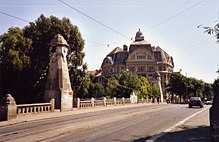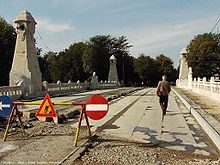Podul Decebal (Timișoara)
Podul Decebal ( German Decebal Bridge , popularly Neptune Bridge ) is the name of a bridge in the western Romanian city of Timișoara (German: Temeswar). It crosses the Bega and is one of the three bridges in the 2nd district of Fabric . This connects it with the inner city district of Cetate . The eastern bridgehead lies between the Neptunbad and the entrance to the Volkspark ( Romanian Parcul Poporului ). The namesake was the Dacer king Decebalus .
prehistory
The Bega used to have several arms in the factory town, on which a large number of water mills were in operation. To make better use of hydropower, the city council decided in 1902 to build the Timișoara hydropower plant and to close the water mills at the same time. The systematisation plan from 1901 to 1903 by the engineer László Szesztay provided for the straightening of the Bega over a length of 2.4 kilometers. Three new bridges were built on this route: at today's Piața Sarmisegetuza, at today's Piața Badea Cârțan and the bridge treated here at the later Neptunbad.
The construction of the bridges was put out to tender . 14 applications were received from companies in Budapest , Timișoara and Arad . The Budapest company Melocco Péter was awarded the contract for the Decebal Bridge. The bridge was completed in 1909 and the Timișoara tram has been using it since August 5th of the same year.
construction
The construction of the Decebal Bridge goes back to Győző Mihailich (* 1877 in Rekasch ; † 1966 in Budapest), who studied at the Technical University in Budapest and then made a name for himself by building concrete bridges .
The executive architect was Albert Kálmán Körössy (* 1869 in Szeged ; † 1955 in Budapest), who had studied at the Technical University in Budapest and at the École des Beaux-Arts in Paris and Munich .
The bridge was awarded an honorary diploma at the 1910 International Exhibition in Paris . With a length of 195 meters and a width of nine meters, the Decebal Bridge was the largest concrete bridge in Europe when it was completed.
Name of the bridge
At the time of the Kingdom of Hungary , the bridge was initially called Liget-úti híd . The name was given to the adjacent street Liget-út , German Parkstraße. Alternative names used less frequently in Hungarian times were Korona híd among the Hungarian population and Park-Brücke among the German population.
After Timişoara in 1919 fell to Romania, said the bridge in the interwar period Podul de pe Aleea Parcului translated Park Avenue Bridge . This name was derived from the adjacent street Aleea Parcului , the former Liget-út .
After the Aleea Parcului was renamed Bulevardul Regina Maria a few years later , the bridge was called Podul Regina Maria . The namesake was Marie von Edinburgh , who was Romanian Queen from 1914 to 1938.
The current official name Podul Decebal, German Decebalbrücke , was finally introduced after the Second World War . An alternative slang term is Podul Neptun , German Neptune Bridge. This is derived from the location at the Neptunbad or Neptunpalais.
Trivia
During the Romanian Revolution in 1989 , security forces opened fire on demonstrators at Decebal Bridge on December 17 after 5 p.m. In the next few hours, 65 were killed and almost 200 injured.
See also
literature
- Árpád Jancsó: Istoricul podurilor din Timișoara. Editura Mirton, Timișoara 2001, ISBN 973-585-545-3 .
- Else von Schuster: A tour of Timisoara. = O plimbare prin Timişoara. 3. Edition. ADZ, Bucureşti 2001.
- Timisoara - Timisoara. A Southeast European city in a changing era. Hometown community Timisoara, Heidenheim 1994.
Web links
- primariatm.ro , Primăria Timișoara: Podul Decebal a împlinit 100 de ani (I) , May 2009, in Romanian
- primariatm.ro , Primăria Timișoara: Podul Decebal a împlinit 100 de ani (II) , September 2009, in Romanian
- welcometoromania.ro , Podul Decebal , in Romanian
Individual evidence
- ↑ daniel-ursprung.ch ( Memento from May 17, 2014 in the Internet Archive ), Daniel Ursprung: The Romanian Revolution of 1989: Chronology of the fall and the trial of Nicolae Ceaușescu and his wife Elena , April 13, 2010
Coordinates: 45 ° 45 ′ 21.7 " N , 21 ° 14 ′ 26.9" E




